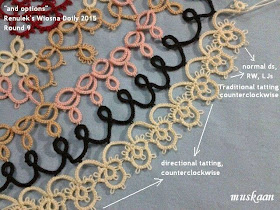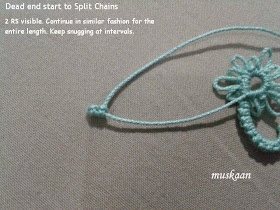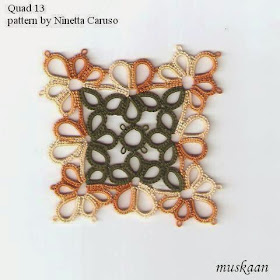Do colours go round & round when tatting a doily ?
Do they Have to?
How about adding colour-stylishness to traditional rounds ?
Renulek’s
Wiosna Doily 2015
Now, I liked the twirling
effect of round 6 & did not want to use 2 colours within (ie. for chains
& rings) since that would break up the ‘continuity’. But how about using 2
colours in segments ?! Why not play around with colour placement ?!
So there I had it ; Collecting Inspiration !!!
Round 6
would be broken into 2-colour repetitive segments & Round 7 would be the
same 2 colours, but in alternating placement to previous round, creating a kind
of undulating wave.
Sharing some of the techniques I used/worked out to put the
visualization to practice.
Switching shuttles midways
through a chain, And a picot required there ! So, Shoe Lace Trick to the rescue,
but with a tiny space that became the picot.
The one shown in photo looks pretty good. But not all
were good. This was very tricky to do since the natural tendency of this
technique was to close the gap.
Why did I not use a Lock
Stitch instead ? Because the colour blip of one unflipped stitch would show.
·
Large Rings (Round 7)
A little way into round 7, I
came across Patty Dowden’s excellent tip
on how to work large rings. Immediately tried it out with the 24ds ring
& it worked Beautifully & smoothly !
In Patty’s own words &
diagrams, which she has kindly permitted me to share here ( Thanks, Patty :-) ) :
Working
with Large Rings
© Patty Dowden 2013
 (This
pattern) calls for large rings that require more than the normal amount of thread
to be wrapped around the left hand that holds the working thread.
(This
pattern) calls for large rings that require more than the normal amount of thread
to be wrapped around the left hand that holds the working thread.
To avoid
moving the working thread back and forth and produce a better double ring, or
causing the thread to fray:
1. Enlarge
the thread wrapped around your hand for each ring by doubling (or more) the
amount of thread you normally use.
Wrap the
excess around your pinkie, as for a chain, except hold the thread above your
pinkie and wrap toward yourself instead of away from yourself. This allows the
extra thread to be easily released one wrap at a time from the outside in.
2. Also,
after making the picot or join at the halfway mark of a ring, leave a loop of
core thread to allow for more easily closing the large ring in two steps. Close
the first half by tensioning the core loop and then finish closing the ring by tensioning
the shuttle thread.
ooooooooooooo
It has many advantages – one
does not have to keep pulling thread from shuttle at intervals ; it keeps the
large ring from distorting ; it keeps the thread from twisting ; keeps the
stitches neat & even ; closes the ring much smoother ! What’s not to like
;-P
But since habits are not easy
to change, I felt more comfortable starting a ring normally, make 2 ds, Then
pull the extra length of thread to wrap around my pinkie. Also, I totally
forgot about the 2nd step, but pulling the thread all the way
through, worked fine for this size ring.
- Switching
colours (Round 7) :
Lock Join for 1st
ring of new segment
Each segment in this round is
made of 6 repeats in one colour, before changing to next colour. At this point
of change, a simple LJ using the core thread shuttle works because it is the
same colour that will be continued for next 6 repeats.
Slope & Roll
join for subsequent rings within segment …
…. accompanied by
Shoe Lace Trick
Also, make an SLT Before
& After the S & R join :
Before, in order to switch
from chain to ring ; and
After, in order to move from
ring to chain.
The S & R join does create a slight mismatch of
surface. But it is a necessary evil in order to avoid the colour blip. The SLT
helps flatten it to some degree. Tiny picot joins work better as noted next.
·
Tiny Picot Join between
Chains (Round 7)
:
As mentioned above, there is
a slight distortion/level-mismatch caused by the S&R join, mitigated only
partially by the SLT. A tiny picot join between chains in round 7 , however, might
have brought the chains more at the same level. This occurred to me halfway
through the round, & didn’t want to ‘change’ at that stage. After all the
next round & some ironing would bring it all together. Yet, caved in
towards the last couple of segments & you can see the difference in the
pic.
·
Wait Before Cutting Out Errors
When in doubt, wait ! Keep
scissors at bay.
After 2 segments of round 7,
I was dissatisfied with the ‘weaving’ effect because of the ring colour that
connected to form a ‘wave’.
But I wasn’t certain a change
would work better. So, kept off the scissors – after all 1/6th round
was already complete - & started tatting a little distance away. I now had
the option to either continue with the 2nd version & snip off
the 1st, or vice versa.
Eventually, I stayed with the
2nd version & snipped off the earlier portion.
My Dissatisfaction :
- The thread colours in themselves were not inspiring
enough. Too similar to bring the experiment to light. Will have to use
black for next round.
- “Interweaving” effect not prominent enough, again
because the colours were pretty similar.
- Secondly, I should’ve used Karen Cabrera’s 2-coloured Ring technique for the “interwoven”/crossover
ring! As indicated in the picture above.
- A mistake exactly halfway through Round 7 which I
discovered only at the very very end ! No patience to cut & redo half
the round again.
Despite my dissatisfaction, I think it is worth trying out
such an experimentation with colours even if one is working on traditional-type
doilies. It probably lends some interest, some character, some modern
stylishness.
Now on to the next rounds ...

































